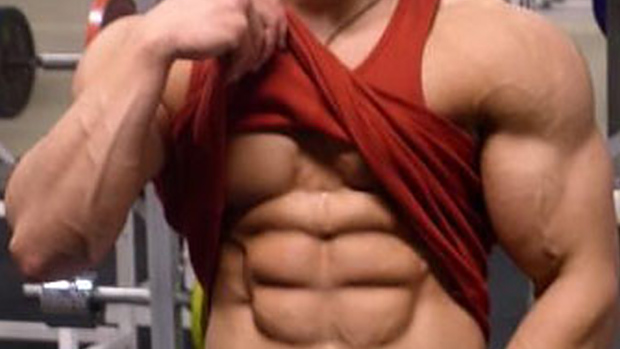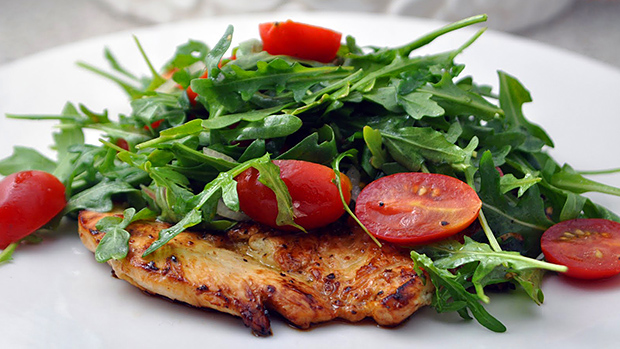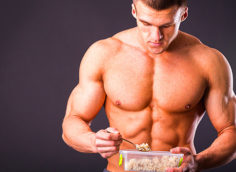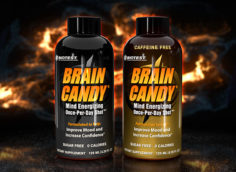Suddenly Sated
Here's what happened. I'd broken the cardinal rule of good, muscle-building, abs-displaying nutrition: I'd gone way too long between meals. Instead of the usual five or six meals per day, I'd only had breakfast. It was 2PM. Oops.
Starved, I pulled into a Chinese buffet. Now, I have rules when it comes to buffets: nothing fried, no breads, no desserts. Those rules usually keep this "cheat" meal somewhat under control, so I piled up a plate and went to town on it. Then I piled up another plate. And finally one more.
But here's the interesting part. Before I dove into the third plate, my cell phone rang. The conversation went on for several minutes. After, I hung up and looked down at my plate. I suddenly realized I was full. Not just full, but stuffed. I couldn't eat another bite. And yet a few minutes ago, before the phone call, I was still hungry and planning to demolish that third plate.
How did I suddenly get satiated?
 |
MSG is yummy.
The 20-Minute Effect
The explanation can be simple or complex. Let's stick to simple. Dr. Janet Polivy, professor of psychology at the University of Toronto, explains it best:
"We don't have immediate feedback from our bodies telling us we've eaten enough. It takes about 20 minutes for food to be digested enough that glucose gets into the bloodstream and the hormones start working."
Those hormones — insulin, leptin, cortisol, and ghrelin — act as chemical messengers that run signals related to hunger and satiety between the stomach and the brain. Problem is, if you stuff the stomach too quickly, your body basically doesn't have time to "hear" the messages. This is why if you eat until you're noticeably full, you often feel nauseatingly stuffed 20 minutes after the meal. You were actually full halfway into your meal; you just didn't know it yet.
Okay, so we have some slow body signals to deal with. Not that big of a deal, right? But there's another factor here: We still have the base physiologies of prehistoric man.
In other words, our out-of-date, slowly evolving bodies aren't made for a world of abundant, calorically-dense foods... or Chinese buffets. Our bodies (and parts of our brains) are still swinging tree branches at saber-toothed jack rabbits and dragging women into the cave by their hair.
 |
Lana. Zug-zug!
What that means is that when we see hot, abundant food, we think "Ug, fresh kill!" and have the innate desire to gorge on it, just like our pre-agriculture, pre-Sub-Zero refrigerator ancestors did. They'd graze on vegetation and have small "meals" until they killed a big animal, then they'd gorge. Thing is, today's "grazing" involves vending machine candy bars, and modern "kill gorging" usually takes place at the drive-thru.
Combine modern man, slow chemical signaling between the stomach and brain, and caveman instincts and what do you get? This:
 |
This perfect storm makes us into fatties and can wreck our attempts at dieting. When we're ready to get ripped, most of us have to do battle with slow hormones, primitive desires, and a world full of cheap, fattening, tasty food.
Here's a few tips for winning that battle:
Tip #1: Manipulate the 20-Minute Phenomenon
Awareness is the first step to success with just about any dietary challenge. In the battle for visible abs, you first need to recognize the annoying 20-minute effect.
 |
Obviously, you need to stop eating before you get full, or at the very least at the first sign of fullness. Twenty minutes later, you'll actually feel full. This takes practice and discipline. It's just not easy for a big weight-training male to walk away from available food when he's not yet stuffed. In many ways, it goes against our instincts.
So when you're dieting and trying to reduce calories:
• Keep a food log. This one goes into the "duh" file, yet many people "diet" without ever tracking their calories and macronutrients (protein, carbohydrate, and fat.) Sorry, but just buying packaged foods marked "low-fat" does not a diet make.
As tedious as it is, you need to count calories and macronutrients at least once in your life in order to see the big picture. For example, I've known dozens of gym "vets" who went for years with suboptimal gains. When they finally tracked their protein intake, they realized they were getting just about enough to support the muscle mass of an anorexic girl scout.
So, let's say your diet calls for 2000 calories per day. Divide that by five meals and you get 400 calories per feeding. You do the deed: You read labels, you weigh and measure food, you consult online calorie guides, you write it all down.
Horrible stuff, I know. But now you have a reason to stop eating: You've consumed your 400 calories. (More importantly, you now know what 400 calories looks like!) Walk away. You will likely not feel "full," but you will about 20 minutes later.
• Eat slower. Put down your fork between bites, just like mama taught you.
 |
Ah, the reward for dietary control!
• Use a small salad fork instead of that shovel you're using now. Better yet, use chopsticks. Use smaller plates too when dieting. Basically, if it's on your plate, you'll finish it, even after you're full.
Researchers at the University of Illinois conducted a study where participants ate from soup bowls equipped with hidden refilling devices. Subjects who ate from these never-ending bowls consumed 73% more than those who ate from regular bowls. But here's the kicker: They didn't rate their feelings of satiety any higher than those who consumed less. You've heard the saying "You eat with your eyes first." It's pretty much true.
• Make a plate and sit at a table. No eating from containers in the kitchen.
• Don't eat in front of the TV. Studies show you eat more when your mind is distracted by television.
• Chew your food more, for gosh sakes.
• Another one for the duh file: Never get starved to begin with. Eating every three hours or so should prevent this. Go too long between meals and you'll eat too fast, bypass the 20 minute effect, consume too much, get fat, and never have a decent looking girlfriend. On a positive note, you'll get really good at World of Warcraft. Congrats on that, killer.
 |
Tip #2: Think High Volume, Low Energy
By "energy" I mean calories. Some foods are calorically dense; others aren't. The idea here is to have low-density foods with every meal so you'll feel full without adding tons of calories. Basically, you're taking up space in your stomach so you don't eat so damn much.
This type of dieting is known as Volumetrics. While I'm not a fan of the particulars of this low-fat diet, we can learn a few things from the approach:
• Have non-starchy vegetables with every meal. Along with all the health benefits, veggies fill stomach space. Starting every meal with a spinach salad is a great idea. Just watch those dressings, which can be energy dense.
A big side of mixed veggies with every meal will only add 30 to 60 calories: lots of volume, takes up lots of room in the stomach, yet adds minimal calories and maximal nutrition. (I like those broccoli stir-fry blends you can buy flash frozen.) Take a look at this:
3/4ths of a cup of white pasta = 210 calories, 41 grams of carbs, 2 grams of fiber
 |
3/4ths of a cup of broccoli-based mixed veggies = 30 calories, 5 grams of carbs, 2 grams of fiber
 |
Forget glycemic index, phytonutrients, and all that stuff for a second and just focus on the volume. There's a 180 calorie difference between the pasta and the veggies, yet the volume of food is the exact same!
Am I saying to never eat pasta and only eat broccoli? No, but instead of having two servings of white pasta, have one serving of whole grain pasta and one serving of veggies. You'll still get your pasta fix but cut out tons of carbs and calories.
Here's another tip: Get some of those microwave steaming bags for your vegetables. From frozen to perfectly steamed in four minutes — that rocks.
 |
But what about those nasty xenoestrogens found in plastics? Well, that stuff concerns me (and my nads) too, but these bags are heat-resistant and food-safe. In the long run, I think a convenient way to get more green vegetables trumps the possible ingestion of a tiny amount of xenoestrogens. The pros outweigh the possible cons. (But just in case, I never miss a dose of REZ-V!) If you're worried though, you can always pick up a dedicated food steamer or do it the old fashioned way.
 |
On other satiety notes, protein will make you feel more full than fats or carbs. Dietary fat scores lowest on the Satiety Index. In fact, high-fat content foods create almost instant cravings for more of the same. On the other hand, foods high in protein and fiber slow digestion and prolong the release of cholecystokinin or CCK, the peptide hormone that triggers the "I'm full" feeling.
This is probably why Metabolic Drive Complete is so satisfying: 41 grams of protein combined with 8 grams of fiber. Nice!
Also, while I think that breads should be avoided 99% of the time, remember that whole grain breads are 50% more filling than white breads according to Holt's Food Satiety Index.
Interestingly enough, bananas are much less satisfying than apples or oranges. And while water-dense whole fruits are generally recommended, avoid fruit juices, which aren't filling at all! Beans and lentils, on the other hand, contain anti-nutrients which delay their absorption, causing you to feel full longer.
Sensory-Specific Satiety
Lastly, be aware of something called "sensory-specific satiety." Basically, you can become "full" eating one kind of food, but when another food is introduced you suddenly feel the urge to "make room" and eat it. This is why you can eat until satiety yet still desire dessert. This of course leads to overeating, nausea, bloating, and, once again, a chronic lack of girlfriend.
(On a side note, perhaps this is evolutionary as well. The tongue wants a variety of stimuli in every meal — something savory, something sweet, etc. Maybe this is our body's way of making us desire different nutrients and different types of foods. Otherwise our ancestors would've been satisfied eating meat all day and would've never looked for fruits [sweetness]. This would lead to deficiencies that could eventually kill and halt the continuation of the species. Again, there's a reason why hunger/cravings are so powerful: This drive, much like the sex drive, helps to propagate the species.)
 |
Here's something I've found helpful in countering sensory-specific satiety. A while back I was eating healthful bodybuilding foods, but I had a tendency to overeat them. For example, I'd eat my chicken breasts and steamed vegetables and be full, but then I'd start eyeballing those tasty Metabolic Drive bars sitting on top of the fridge. I was full but I wanted "dessert." And since Metabolic Drive bars are good for you, I'd justify over-consuming calories for that meal.
The solution was prunes. Really, no kidding. When the dessert desire kicked in, I'd have one or two "Ones" — sweet, individually wrapped dried plums. This satisfied my sweet palate for only 25 calories instead of 240, and allowed me to save the protein bars for times when I really needed them, like traveling. Try it!
 |
Tip #3: Recognize the Proximity Problem
Finally, we must consider the issue of proximity or how physically close we are to food. We sometimes eat not out of hunger, but out of proximity and visibility.
The most interesting study about this looked at the snacking behaviors of 40 secretaries. Proximity was manipulated by placing chocolates on the desk of the secretary or two meters away from the desk. Visibility was manipulated by placing the chocolates in covered bowls that were either clear or opaque.
The results? Exactly what you'd expect: The secretaries ate more chocolates when they were easily within reach, and they ate more when they were visible instead of covered. And the kicker here is that they usually didn't realize they were consuming more calories from closely-placed foods.
This is pretty amazing when you think about it: If a human being sees food within reach, he'll eat it, even if he's not hungry. If that same food is a few feet away and/or hidden from view, he's less likely to eat it. Makes you think twice about getting one of those fancy see-through refrigerators, huh?
 |
Here's how I apply this info in real life. First, I generally don't keep crap foods in my house. I may get a craving for something unhealthy, but if I have to get in my truck to go get it, I'll most likely eat something in closer proximity, which is healthy food.
Second, while my daughter eats healthier than most any other kid I know, she does have some treat foods in the house. I simply put these in a separate cabinet. Out of sight, out of mind. That's a good trick to use with your fat roommate's junk food too.
I've also learned to get the Metabolic Drive® Bars off the top of the fridge (visible and proximate) and into a cabinet. Otherwise I'd eat four or five per day!
Again, these bars are healthy and full of protein, but it's easy to overeat them. Remember, while a calorie is not a calorie, calories do count!
Proximity problems also occur when preparing foods, especially in a family setting. I've worked with numerous housewives who "don't have time to eat" yet are overweight. I look them in the eyes and politely say, "Bitch, you must be eatin' something!"
Okay, I'm kidding. But it is very easy to nibble as you cook or prepare your kids' lunches. While never sitting down for a meal, you can "accidentally" consume hundreds of extra calories.
The proximity and visibility problem is also directly related to the 20-minute delayed satiation effect. You're not going to allow the feeling of fullness to kick-in if you don't remove yourself from the food. In my early days of struggling with diet and willpower, I'd find myself standing in the kitchen and looking in the fridge when it wasn't time to eat. This was a habit. I noticed I was "hungry" in the kitchen, but satisfied when I was in my office.
If you find yourself about to blow your diet, simply get out of the kitchen or the presence of food. Two minutes later you'll be back in control and shocked that you were about to wreck your nutrition plan.
I've advised many Velocity Dieters to take their recommended NEPA walk in the evening. Why? Because nighttime is the "danger time" when it comes to overeating, and binge eating at night is what keeps most people fat. Going for a walk burns some calories, aids in recovery from weight training, and, most importantly here, gets the V-Dieter away from the damn fridge!
You can also take advantage of the proximity/visibility phenomenon. Working on increasing your water intake? You'll drink more if you keep water close by and out in the open. If you're serious about your fluid intake, consider a home water cooler.
 |
Just be sure to watch Desperate Housewives so you'll have something to talk about while standing beside it. That Gabrielle, she is just so saucy!
Summary
If you struggle to get lean and stay lean, then keep these tips in mind:
1. Be aware of the 20-minute satiety delay.
2. Include high bulk, low-calorie foods in every meal.
3. Harness of the power of proximity and visibility.
 |
Simple tips? Yeah. But judging from the rising body fat percentages of even trained individuals, these simple steps can have dramatic physique transformation effects! Try them!





